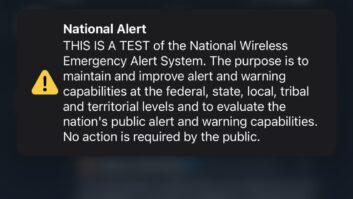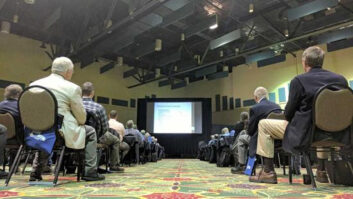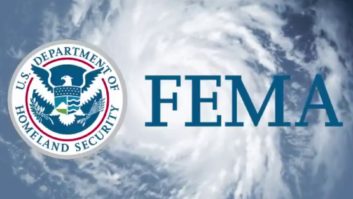FEMA is getting questions from broadcasters about several issues related to the June 30 CAP-EAS deadline.
Most have to do with the mechanics of EAS encoder/decoder configuration and Internet connectivity-related queries about how to connect to FEMA IPAWS Web aggregator to get EAS alerts.
Radio World asked FEMA to share some of the questions posed during last week’s EAS webinar, along with FEMA’s answers. Here are some of the most interesting questions and answers concerning CAP, provided by Maine Association of Broadcasters President/CEO Suzanne Goucher. IPAWS Program Manager Al Kenyon answered the questions except where otherwise indicated.
Q: When we go to the CAP system end of June will we still use our old EAS system?
A: Yes, CAP is an overlay with extended capability.
Q: I understand the security signatures need to be fixed. Are present CAP messages through IPAWS adequately secure?
A: Vendor observations helped FEMA track down a problem where some CAP messages with valid signatures signed through a particular process had their digital signatures damaged during subsequent processing prior to these messages being posted to the CAP-EAS Atom feed. This has been resolved. At no time were incoming messages without valid digital signatures posted to the CAP-EAS Atom feed.
Q: We don’t have a configuration that allows us to check for validating signatures.
A: That may be due to the vendor reading of Part 11.56(a)(2) of the FCC Rules. The commission makes specific reference to the OASIS Common Alerting Protocol Version 1.2. The standard Implementation Note 3.3.4.1 states: “Processors MUST NOT reject a CAP Alert Message containing such a signature simply because they are not capable of verifying it; they MUST continue processing and SHOULD inform the user of their failure to validate the signature.”FEMA will work with the FCC, the vendor community and ECIG to resolve this issue. This group will issue guidance to broadcasters to only process EAS messages with valid signatures.
Q: Digital signatures on CAP messages are optional, correct? Why not mandatory?
A: IPAWS OPEN requires a valid digital signature on messages processed for dissemination via EAS and CMAS. Digital signatures are optional for other CAP messages processed through IPAWS OPEN such as agency to agency messaging.
Q: Is latency of the Internet provider an issue for proper reception of CAP messages?
A: (From Mark Lucero, FEMA) Internet latency (up to several seconds) is not an issue for reception of CAP, though it does affect the promptness of alert delivery to the public.
Q: RWTs should be firing off now; each Monday?
A: (From Suzanne Goucher, MAB/NASBA) FEMA has been sending RWTs every Monday for the past several months, at 11:05 a.m. Daylight local time, 10:05 a.m., Standard local time, by time zone. The chart of RWT time zones may be found here.
Q: So starting July should we monitor the IPAWS CAP server and expect RWT every Monday?
A: (From Suzanne Goucher) Yes, but you can start monitoring now. They have been sending the RWTs for the past several months.
Q: Could we have a few extra RWTs sent during June to help stations that are still installing gear to check … more than once a week?
A: FEMA will issue RMTs daily Monday through Friday beginning June 11 until Friday, June 29.
Q: We receive RWTs from all time zones. Is that a box configuration issue?
A: Most likely your CAP-EAS device has not been configured to ignore RWTs targeted beyond your operational area.
Q: We have been receiving tests but multiple state tests are coming down and not specific to our area. Is this a FIPS code misconfiguration possibly?
A: The FEMA RWTs are directed to states roughly grouped by time zone. If you are receiving tests that are not directed to your state it is likely your CAP-EAS device has not been configured to ignore RWTs targeted beyond your operational area.
Q: What is the URL for the North and South Carolina CAP servers?
A: (From Suzanne Goucher) For those specific CAP feeds, check with your state emergency management agency as to whether they are CAP-capable. The list of states that have been approved, or applied, for access to the FEMA IPAWs server is here.
Q: Where do I find New York state’s CAP server and information?
A: (From Suzanne Goucher) Check with your state emergency management agency or state emergency communications committee.
Q: What is the URL that we need to monitor for CAP alerts?
A: Contact your EAS device manufacturer for specifics on how to connect to the FEMA CAP server. The base URL is: apps.fema.gov.
Q: Do you have an address for the ATOM feed?
A: (From Suzanne Goucher) Here’s what FEMA says: We are directing EAS participants to check with their device manufacturers because methods of entry and PIN numbers for various devices are different.The base URL is: apps.fema.gov.
Q: We haven’t been able to poll FEMA. We’ve tried to ping the apps.fema.gov site. Should we get any response back from that ping or is it blocked?
A: By design the server at the apps.fema.gov web address will not respond to ping requests.
Q: Outside of installing and configuring the manufacturer’s CAP equipment is there anything else we need to do to poll and get IPAWS feeds? Do we need to contact FEMA for authorization or does the manufacturer’s equipment onboard software do all the rest for polling?
A: If you follow the manufacturer’s instructions and have established a good Internet connection it should work. Understand that there most likely will not be a message waiting to be retrieved. Most CAP-EAS devices will indicate through display or logs if they have successfully polled. The device manufacturer can provide you with all the information you need to set-up and poll the IPAWS feed.
Q: So at this point if you have a FEMA COG(Collaborative Operating Group), and are sending EAS messages to IPAWS will they be relayed over NOAA Weather Radio?
A: If your COG is authorized for HAZCOLLECT, messages will be routed to NOAA for further dissemination. (See more on COGs here.)
Q: Will the NPR Squawk box send CAP messages?
A: No, the agreement with NPR just covers distribution of national level EAN messages in audio format.
Q: Will NPR be doing weekly tests?
A: The PEP NPR feed is limited to national level EAN feed.
Q: What do we do if our state does not have a CAP server on June 30?
A: Some states may not choose to implement their own CAP server. All states and approved local jurisdictions are welcome to use the FEMA OPEN CAP message aggregator free of charge.
Related:











